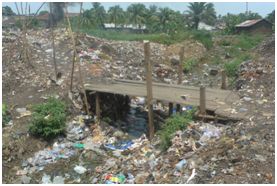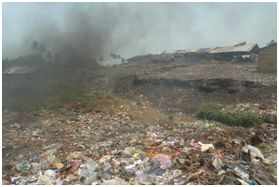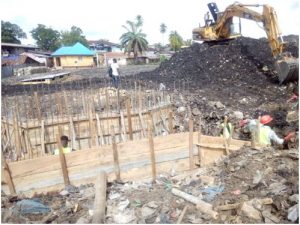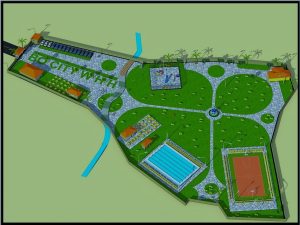Stepwise Transformation of an old illegal dumpsite in the City of Bo for recreation
- 20-acre piece of land was leased out to Bo town in early 1950s for development into a public park to be named “Peaston Park”, the town council was to regularly pay annual lease rent to the land holding families (three families) .
- Transition of Bo from town to city status, degeneration of Sierra Leone into 11 years of civil war and lawlessness and a lull that ensured in keeping with the agreements lead to some land holding families and town officials to informally repossess and hive off the land for private development.
- The 20-acre parcel of land was overtime encroached and transformed into mixed development leaving only 3.6 acres that was turned into an illegal dumpsite, a hideout for criminals, and other small scale businesses
- Waste piled up over the years to more than three metres high, temporary structures continued to spread on top of the waste piles, some section turned into open defecation sites while other areas remained under continuous fire making it one of the worst pollution sources in the city.


Reclamation process
- The law of Sierra Leone gives the right to an individual to own a piece of land as long as he/she has illegally been operating on it for more than 10 years without objection from any claimant. Even though it was not clear how long the illegal settlement on Bomeh dumpsite had been, the repossession had to be a negotiated.
- A working committee comprising the land holding families, paramount chief, the Bo city council, the civil society, Environmental protection agency among others was set up and headed by the senior district officer.
The team did an assessment of the illegal settlement (including actual ownership) and their values at the Bomeh site and a time line for relocation including nominal compensation rate to enable them remove their structures - Proposed development design was prepared and approved by the working committee
- Political goodwill was also sought by organizing a delegation to the Vice President to present the proposed design for Bomeh and hence the reason for his support.
- One of the business owner at Bomeh disputed the development and related relocation and sought court protection against the project listing the Paramount chief as first respondent and the Mayor of Bo city council the second. The level of interest and rejection from across the stakeholder committee against the case forced the court to visit Bomeh site from where the chief judge ordered immediate clearance and restoration of the site through the proposed project basing judgement on the potential environmental and health hazards.
- All the illegal structures were marked and official notice for site clearance issued, compensation dates set and contract issued to commence site clearance


Challenges
- Waste volumes on areas under structures were too higher than what had been envisaged during project formulation and budgeting. The project had transported 30,000 tons of waste as was provided for in the budget, but this only covered 1.5mters top layer, more than 2 metres of clearance still required to reach the level upon which the planned facilities could be installed.
- Most parts of the site on high water table/swampy texture hence would require high volume of backfilling during fencing and levelling for the intended aesthetics
- Budget deficit and call for the review of the site plan to reduce on costs
Development status and way forward - The entire 3.6 acres cleared of all illegal structures and 30,000 tons of waste cleared.
- Tender already advertised sourcing for a contractor to build the perimeter fence to secure the land
- Additional funding being sourced to meet the site clearance, backfilling and aesthetics. Strategy is to do manual screening of all inorganic waste using manual labour through food for work contractual procedure. World Food Program of the United Nations have agreed to provide assorted food items in support of the project.
- A review of proposed structures for the recreation facility is ongoing to reduce on cost. Innovative approach to certain proposed infrastructure are under consideration to maintain high level aesthetics while at the same time reducing the cost – value for money

